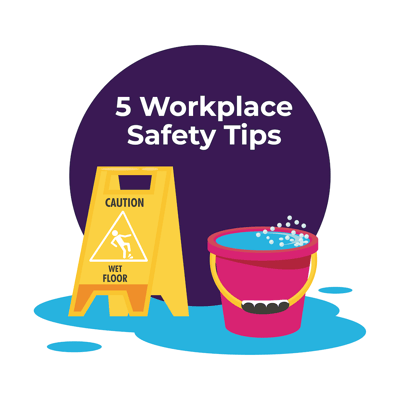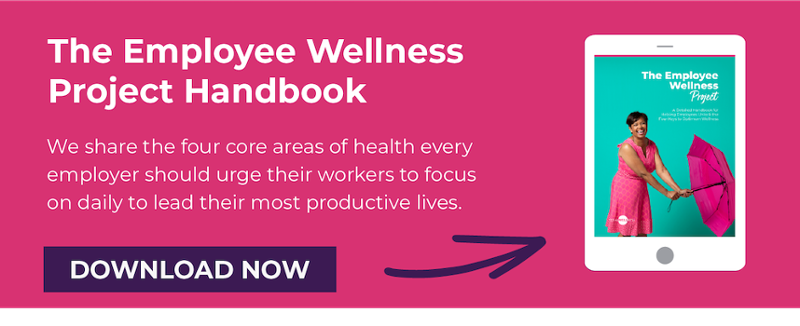 How safe is your workplace?
How safe is your workplace?
If you’re thinking some updated training and shared workplace safety tips might be long overdue, June is the month to reflect.
June is National Safety Month, a prime time to discuss workplace safety tips. It’s also the 25th anniversary of the observance, which encourages safety in communities, workplaces, and in the home.
In 2019 alone, there were over 5,000 fatal workplace injuries, according to The National Safety Council — the highest since 2007. Don’t let your workplace be one of those statistics this year.
Below, we share workplace safety tips and engagement ideas to promote National Safety Month.
Here’s to a safer workplace for all!
Tip #1: Prevent Incidents Before They Start
Ways to reduce accidents and incidents include identifying major risks and taking proactive safety measures. That also includes avoiding shortcuts and rushing job tasks for the sake of getting things done faster. Following the appropriate safety procedures and protocols generally ensures the safety of all employees in any given department. As an employee, make it a top priority to understand all safety protocols thoroughly. Unsure? Ask your department lead or manager for a refresher.
Leadership tip: Offer weekly or monthly safety training as needed for your individual departments. Complacency is one of the number one ways people end up getting injured on the job. Don’t let complacency cause injuries in the workplace.
Tip #2: Focus on Good Posture
Whether you’re sitting or standing all day, focusing on good posture helps the body maintain its ability to balance. It can also strengthen your ability to participate in a variety of physical and enjoyable activities including tennis, dance, golf, running, and more. Posture can also have an impact on headaches frequency, energy levels, and neck tension. Ensuring your posture is properly aligned can keep you from ongoing health issues like headaches and back pain.
Good posture means:
- Your chin is parallel to the floor
- Your shoulders are even
- You have a neutral spine
- Your abdominal muscles are tight
- Your hips and knees are even
- You keep body weight evenly distributed
Posture impacts more than you think. Check in with yourself regularly throughout the day to ensure your spine is straight and your shoulders aren’t slouching forward. In time, you’ll find it isn’t as hard to keep proper posture.
Leadership tip: Invest in ergonomic equipment for your employees to encourage good posture. Back braces, comfortable work chairs, and customized workstations can keep your employees safe and healthy.
Tip #3: Take Regular Breaks
Frequent breaks are an excellent way to provide an immediate stress relief opportunity in the workplace. If a coworker or work activity is being challenging, step away. Taking a break also forces you to physically get up and move out of your work space, which improves circulation and blood flow. Normally scarf your lunch down at your desk? Step away. If you work 24/7 without breaks, it will leave you feeling overwhelmed and stressed-out — always an unhealthy and unsafe workplace practice.
Leadership tip: Encourage frequent breaks for your in-house and remote employees. Ask them to try something new on their lunch break this week and extend their time to allow them to add in some self-care, exercise, or meditation time.
Tip #4: Do Your Best to Minimize Stress
Reduce work stress when possible to stay healthy both mentally and physically. By knowing the physical and emotional signs of stress, you can better manage your symptoms and workloads. It’s important to know that work stress effects may range from mild to severe.
Physical signs of stress include:
- Fatigue
- Sweating
- Chest pain
- Indigestion
- Muscle tension
- Heart palpitations
- Low immune system
- Pains and headaches
Psychological stress symptoms may include:
- Irritability
- Anxiousness
- Memory issues
- Trouble sleeping
- Poor decision making
Long-lasting stress can have severe consequences on mental health and the physical body. Finding ways to manage stress in a healthy way benefits you both short-term and in the long haul.
Leadership tip: As much as possible, create a stress-free and healthy workplace environment. Excessive stress in the workplace means the workplace is not safe; leadership is responsible for safety. Take charge and ask employees how you can help. Check out 23 Expert Anxiety Management Techniques to Help Your Employees.
Tip #5: Stay Alert
Exhaustion will take its toll on you if you aren’t careful. And if you work the night shift, safety incidents are 30% higher, according to The National Safety Council. No matter what your job, there are likely dangers to yourself and others if you fall asleep on the job. If you find yourself nodding off while heading to work, it may be the day you need to call off or ask to come in later. If you’re constantly sleep-deprived, you may want to see a healthcare provider to tackle the issue.
Leadership tip: Set a cap to working overtime. Employees who exhaust themselves working are more likely to suffer from chronic stress, insomnia, and other physical ailments. Encourage your team to take vacation days and to take time off if they need rest.
Engage Your Team When Sharing Workplace Safety Tips
Remind your team how most workplace injuries and deaths are preventable simply by following workplace safety rules and protocols. Even if it’s as simple as wearing goggles on site, these are essential reminders that can help reduce injuries and even save a life.
Here are a few ways to share workplace safety tips in an engaging way:
- Post Injury on the Job Details - During National Safety Month, take time to update any outdated safety policies and procedures. Cover them briefly in a meeting and be sure to email and visibly post on a bulletin board what was covered. Additionally, make sure your team knows who to contact for reporting job injuries.
- Take a Tour of Your Workplace - Get your employees up and moving for this activity. If your team works in a physical labor job, this is an ideal way for leadership to actively see where slip-ups can happen. Tour the work site prior to taking your crew on a tour to see where safety hazards are present. Even in an office setting, there are plenty of opportunities to go over workplace safety tips — like where to meet in the event of a fire or how to prepare for an active shooter situation.
- Have a Safety Training Class - Sometimes it’s necessary to have a refresher course. If it’s been a while since your workplace has covered safety rules, take this month to make it a priority. Host a class or have a series of several interactive workshops throughout the month to engage your staff. Consider doing this throughout the year, too, as your company updates safety policies.
- Share Workplace Safety Materials - The National Safety Council website offers a ton of tools and resources for employers to take advantage of during National Safety Month and beyond. Find materials to share on a variety of topics including work fatigue, safe driving, injury facts, and more.
- Share Funny Workplace Safety Rules - For whatever reason, people tend to remember concepts, ideas, and activities better if they’re tied to humor. If you want your employees to remember your safety training event or workplace safety tips, infuse some humor. The site High Speed Training shares some hilarious health and safety rules that would make most people laugh.
Do you have any workplace safety tips to engage staff during National Safety Month? Feel free to share in the comments below!



